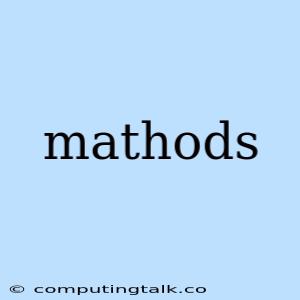Methods: The Backbone of Object-Oriented Programming
In the world of computer programming, methods are fundamental building blocks of object-oriented programming (OOP). They encapsulate the actions and behaviors that objects can perform, making code more organized, reusable, and maintainable.
Imagine a real-world object like a car. A car has attributes like color, model, and year, but it also has actions it can perform, like accelerating, braking, or turning. These actions are represented by methods in OOP.
What are Methods?
In essence, methods are functions associated with a specific object or class. They define how an object responds to certain stimuli or instructions. Here's a breakdown:
- Objects: Think of objects as instances of a class. They represent real-world entities with unique properties and behaviors.
- Classes: Classes are blueprints or templates for creating objects. They define the structure and behavior of objects of that type.
- Methods: Methods are functions that belong to a class or object. They define the actions that an object can perform.
Why Use Methods?
Using methods offers numerous advantages:
- Encapsulation: Methods hide the internal implementation details of an object from the outside world. This allows you to change the implementation of a method without affecting other parts of your program.
- Code Reusability: Methods can be called repeatedly with different arguments, reducing the need for redundant code. This makes your code more efficient and easier to maintain.
- Data Protection: Methods can be used to control access to an object's data, preventing unauthorized modifications.
- Modularity: Methods break down complex tasks into smaller, manageable units, improving code organization and readability.
Defining and Using Methods
Here's a simple example in Python to illustrate how to define and use methods:
class Dog:
def __init__(self, name, breed):
self.name = name
self.breed = breed
def bark(self):
print(f"{self.name} barks!")
my_dog = Dog("Buddy", "Golden Retriever")
my_dog.bark() # Output: Buddy barks!
In this example, the Dog class defines a method called bark. When we create an instance of the Dog class and call the bark method, the dog's name is used to personalize the output.
Method Types
There are various types of methods in OOP:
- Instance Methods: These methods operate on specific instances of a class and can access and modify instance variables.
- Class Methods: These methods belong to the class itself and operate on the class as a whole.
- Static Methods: These methods are not associated with any specific instance or class, and they don't have access to instance variables.
Important Considerations:
- Naming Conventions: Use clear and descriptive names for your methods.
- Parameters: Methods can accept parameters to customize their behavior.
- Return Values: Methods can return values to the caller.
Methods are an integral part of object-oriented programming, making code more organized, reusable, and robust. By understanding the principles of methods, you can write more efficient and maintainable code.
